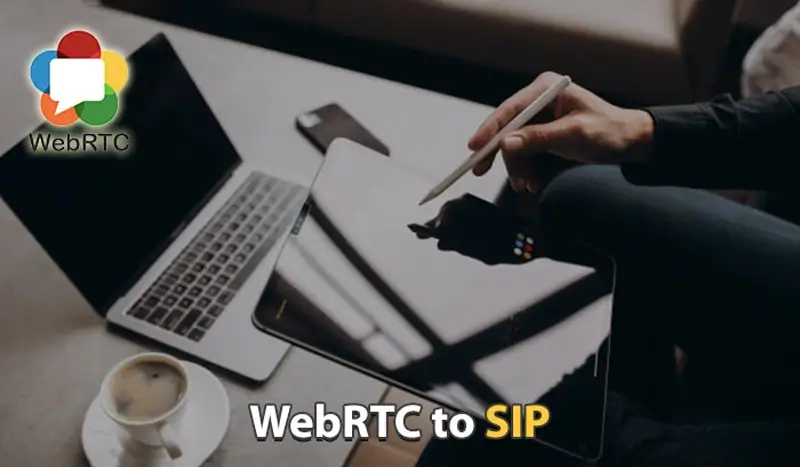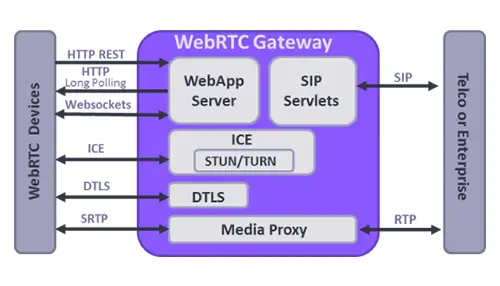WebRTC is one of the most reliable and smooth Real-Time Communication platform that made audio as well as video communication easier. WebRTC allows its users to communicate with each other through the browsers only instead of any additional plug-ins or servers. It has become the most widely accepted and appreciated platform among users as well as developers as per the current survey.
Have you ever heard about WebRTC to SIP? Do you know how it works? Do you know what the features of WebRTC to SIP are? Do you know anything about WebRTC to SIP gateway? The following post will boost your knowledge regarding these things.
WebRTC has this amazing feature to merge different mediums of communication. You can take the example of VoIP (Voice over Internet Protocol) that makes phone calls through the internet. That has become an independent business in its area. Usually, the employees at the call center, office spaces, and many other fields use this activity to make phone calls. But WebRTC is determined to merge all of these practices in the internet browser of an average user. WebRTC to SIP is one of those steps.
SIP stands for Session Initiation Protocol, which is a VoIP protocol that is being widely used by developers as well as users for managing multimedia communication over Internet Protocol. Its services are providing over IP-PBX and Unified Communication platforms to customers.
WebRTC to SIP
This enables its developers to improvise the real-time communication potentiality of WebRTC. WebRTC platform has its VoIP architecture to provide the users with ascendable as well as geographically stable calls. WebRTC to SIP call takes place when a user tries to connect to a desk phone with the help of browsers such as Chrome, Firefox, etc. Apart from these, we can also use this while a user wants to connect with a technical support line by using either Firefox or Chrome instead of picking up the phone and dial the number. So it makes the work easier for the user.
WebRTC is developed by certain coactive powers including a module called SPLIT which is especially enabled to control the media streams over any communication among the user and SIP Softswitch.This is a development based upon the highest level assimilation of voice as well as data.
How Does WebRTC to SIP Work?
When WebRTC is executed on a well-developed SIP platform like OdiTek Solution’s, the applications can be easily operated exactly like phones inside the browsers with the help of developers. When WebRTC is completely merged with the service provider’s platform like OdiTek’s, it supports the browsers to make phone calls to their representatives or sales personnel, who complete their works with desk phones. This feature will help you transfer your entire calling process to business into a single click operation.
Now-a-days every business wants to stay updated with the new technologies hence they want to convert the orthodox telephony boundaries to WebRTC to SIP’s internet telephony.
These are the steps through which WebRTC to SIP works-
1. Audio streaming and signaling
2. WebRTC to SIP transforming
3. DTMF(Dual Tone Multi Frequency) enabled
4. SIP headers overload
WebRTC vs. SIP
Both the platform provides collaboration as well as communication over the internet. So, are they same? Here the answer will be No. They are similar but not completely the same. There are enough similarities between WebRTC and SIP. This may make you feel that both are each others competitors but no, that’s not the exact scenario.
SIP has been popular over the last few decades because of its communication as well as collaboration feature in phone calls, video calling, instant messaging, etc. These things are usually accessed by the user over soft-phone software which is pre-installed on PC, Tab, or Mobile and a VoIP protocol.
SIP is also used by WebRTC under the hood for audio, video calling, instant messaging, file sharing, etc. Unlike SIP, WebRTC doesn’t require any intermediary step or soft-phones since the users can access the services from simply from web browsers.
But a question may arise whether WebRTC and SIP are dependent on each other? Then the answer will be no because they are two separate technologies and both can work independently. That means SIP can be used without WebRTC. But from the user’s experience, it is observed that WebRTC with SIP makes the communication process easier without using any additional plug-ins. Then users will no longer be asking for new software for audio, video, and data sharing.
WebRTC to SIP Gateway
It connects WebRTC to VoIP platforms like SIP. When two browsers using different service provides want to connect among them then they require a VoIP signaling protocol such as SIP to keep them connected. The component which acts as mediatory between WebRTC and SIP is termed as WebRTC-to-SIP gateway. It also enables a WebRTC phone user to communicate between VoIP and PSTN phones. Hence, we can say that the WebRTC gateway amplifies the scope provided by WebRTC applications.
Features of WebRTC to SIP Gateway:
a. Media Quality: Due to WebRTC to SIP gateway, the media path length and delay will be minimized with the help of the best available codec. That will provide extremely clear quality of audio and video calls.
b. Optimized: The media routing will be offloaded when required ensuring low cost and optimized data.
c. Flexibility: Since the gateway will load optimized settings by default, there will be more options left upon which you can operate if required.
d. GUI: It has easy set-up as well as configuration wizard having a GUI based configuration that includes routing configuration, system monitoring.
e. UC: It will facilitate you with social networking capabilities as well as unified communication enabling easy call between the users having support over file sharing, instant messaging, high definition video, and audio.
f. Works in all conditions: The gateway will adapt to your NAT and will auto-decide the best transport method out of all the other methods available. Thus ensuring complete compatibility for all the other browsers despite NAT or firewall being used by the other side.
Protocols It Deals With:
1. Transport protocols: TCP, UDP, TLS, DTLS, and Web Socket, etc.
2. Codecs: G.711, Opus, Speex, G.722, G.723, iLBC.
3. Call Protocols: WebRTC, SIP, IMS, RTP/RTCP, ICE, STUN, TURN,etc.
CONCLUSION
WebRTC and SIP both provide a platform for collaboration and communication over the internet. WebRTC to SIP provides the potential to develop and improvise the Real-Time Communication platform. OdiTek Solutions have a completely developed SIP platform that enables the developers to improve the Real-time Communication competences of WebRTC. We offer an ascendable as well as geographically distributed SIP architecture. We will provide you with SIP-PSTN gateways that will use SIP as a negotiator browser to make a call to old telephones.







